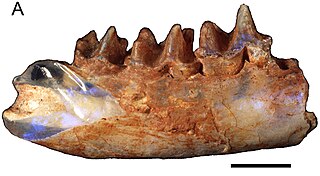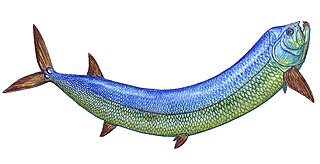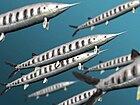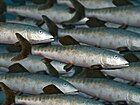
Steropodon is a genus of prehistoric platypus-like monotreme, or egg-laying mammal. It contains a single species, Steropodon galmani, that lived about 100.2–96.6 million years ago (mya) during the Cretaceous period, from early to middle Cenomanian. It is one of the oldest monotremes discovered, and is one of the oldest Australian mammal discoveries. Several other monotremes are known from the Griman Creek Formation, including Dharragarra, Kollikodon, Opalios, Parvopalus, and Stirtodon.

Neoceratodus is a genus of lungfish in the family Neoceratodontidae. The extant Australian lungfish is the only surviving member of this genus, but it was formerly much more widespread, being distributed throughout Africa, Australia, and South America. Species were also much more diverse in body plan; for example, the Cretaceous species Neoceratodus africanus was a gigantic species that coexisted with Spinosaurus in what is now the Kem Kem Formation of Morocco. The earliest fossils from this genus are of Neoceratodus potkooroki from the mid Cretaceous (Albian-Cenomanian) Griman Creek Formation of Australia; remains from the Late Jurassic of Uruguay assigned to this genus probably do not belong to the genus.

Cooyoo is an extinct genus of ichthyodectid fish known from the Lower Cretaceous. It contains a single species, C. australis, known from the Albian-aged Toolebuc and Allaru Formations of Queensland, Australia. C. australis was originally named by Arthur Smith Woodward as a species of Portheus in 1894, which was later amended to Xiphactinus.
The Toolebuc Formation is a geological formation that extends from Queensland across South Australia and the Northern Territory in Australia, whose strata date back to the Albian stage of the Early Cretaceous. Dinosaurs, pterosaurs, plesiosaurs, ichthyosaurs, protostegid turtles, sharks, chimaeroids and bony fish remains are among the fossils that have been recovered from the formation.
The Allaru Formation, also known as the Allaru Mudstone, is a geological formation in Queensland, Australia, whose strata date back to the Early Cretaceous. Dinosaur remains are among the fossils that have been recovered from the formation.
Aphnelepis is an extinct genus of prehistoric freshwater ray-finned fish that lived during the Late Jurassic epoch. It contains a single species, A. australis, from the Talbragar River beds of New South Wales, Australia.
Oreochima is an archaeomaenid ray-finned fish from Lower Jurassic-aged freshwater strata of Queen Alexandra Range, Antarctica. Fossils come from the Lower Jurassic Mawson Formation (Toarcian) of Storm Peak, Antarctica, where a freshwater lake system, called "Lake Carapace", once existed. O. ellioti is also notable for being one of few archaeomaenid genera found outside of Australia, as well for be one of the oldest members of the family.
Aetheolepis is an extinct genus of ray-finned fish which lived in freshwater environments in what is now Western Australia and New South Wales during the Jurassic period. It contains one species, A. mirabilis. Aetheolepis was previously thought to be an archaeomaenid, until a 2016 study instead recovered it as a member of the family Dapediidae. Like other dapediids, it had a deep, discoid-shaped body. Fossils of A. mirabilis have been found in the Talbragar River fossil beds of New South Wales and the Colalura Sandstone of Western Australia. It was named by Arthur Smith Woodward in 1865 along with other Talbragar fish.
Chrotichthys is an extinct genus of prehistoric freshwater ray-finned fish that lived in the Anisian stage of the Middle Triassic epoch. It contains a single species, C. gregarius, known from the Terrigal Formation of New South Wales, Australia.

Archaeomaene is an extinct genus of freshwater ray-finned fish that lived in what is now Australia during the Late Jurassic. It is a monotypic genus, containing only the species Archaeomaene tenuis, which is known from the Talbragar River beds of New South Wales.

Coccolepis is an extinct genus of prehistoric marine ray-finned fish in the family Coccolepididae. Originally including most species within the family, it is now restricted to two species from the Late Jurassic Solnhofen Limestone of Germany. The holotype of C. bucklandi, designated and described by Louis Agassiz, was thought to be lost but was later rediscovered in Neuchâtel.

Morrolepis is an extinct genus of prehistoric coccolepidid "palaeoniscoid" ray-finned fish that lived during the Late Jurassic and earliest Cretaceous epochs in Europe, Asia and North America.

The Talbragar fossil site is a paleontological site of Late Jurassic (Tithonian) age in the central west of New South Wales, Australia. It lies about 30 kilometres (19 mi) north-east of the town of Gulgong, and 300 kilometres (190 mi) north-west of Sydney. The site has been known for over a century during which it has been extensively excavated to the point of near exhaustion. It is now registered as a Crown Land Reserve for the preservation of fossils; access is by permit, and the collection of rocks and fossil specimens is prohibited. The 4-hectare (9.9-acre) reserve is listed on the Register of the National Estate.

Archaeomaenidae is an extinct family of stem-teleost fish found in freshwater environments of Jurassic New South Wales of Australia, China, and Antarctica, and in Lower Cretaceous New South Wales and Mongolia.

"Agathis" jurassica is an extinct coniferous tree found in the Talbragar Fish Beds of New South Wales. The beds were discovered in 1889 near the Farrs Hills in the Talbragar River valley. Specimens from the area were briefly examined by Australian palaeontologists upon discovery and published by R. Etheridge Jr. later that year. The initial classification identified Agathis jurassica as Podozamites lanceolatus. This name was upheld through further inspections by Walkom in 1921, but the species was reclassified as Agathis jurassica in 1981 by Mary White. In 1999, placement in Agathis was doubted, and the species has been referred to as Podozamites jurassica. The species is found predominantly in the Southern Hemisphere with marginal expanses into the Northern Hemisphere.

Coccolepididae is an extinct family of ray-finned fish, known from the Early Jurassic to Early Cretaceous, most of which were originally referred to the type genus Coccolepis. They had a widespread distribution, being found in North and South America, Australia, Asia and Europe. They are mostly known from freshwater environments, though several species have been found in marine environments. They are morphologically conservative, and have poorly ossified endo and exoskeletons, which usually results in poor preservation. This makes it difficult to distinguish species. They are generally small fish, with the largest known specimens reaching a length of 210 mm. Historically, they have been classified as members of “Palaeonisciformes”, a paraphyletic grouping of non-neopterygian fish, due to their plesiomorphic conservative morphology closely resembling those of many other groups of primitive fish. Some recent authors have suggested that they may belong to the order Chondrostei as relatives of the Acipenseriformes.
Turseodus is an extinct genus of ray-finned fish found in Late Triassic freshwater sediments of the United States. Two species have been described, T. acutus from the Lockatong Formation of Pennsylvania, and T. dolorensis from the Chinle Formation of Colorado.

Pholidophoridae is an extinct family of primitive stem-teleost fish that lived during the Triassic period, from the Anisian age of the Middle Triassic to the Norian age of the Late Triassic. Most of the genera are from Europe, but one (Malingichthys) is known from China. The pholidophorids were historically united with several other stem-teleost lineages into the order Pholidophoriformes, but Pholidophoriformes in its traditional sense is now considered paraphyletic with respect to crown group teleosts.
Pteroniscus is an extinct genus of prehistoric "palaeoniscoid" ray-finned fish that lived during the Jurassic period in what is now Kazakhstan, Central Asia. Fossils were recovered from the late Middle Jurassic or early Late Jurassic (Callovian/Oxfordian) Karabastau Formation in the Tian Shan mountains.
This list of fossil fish research presented in 2024 is a list of new taxa of jawless vertebrates, placoderms, acanthodians, fossil cartilaginous fishes, bony fishes, and other fishes that were described during the year, as well as other significant discoveries and events related to paleoichthyology that occurred in 2024.


















